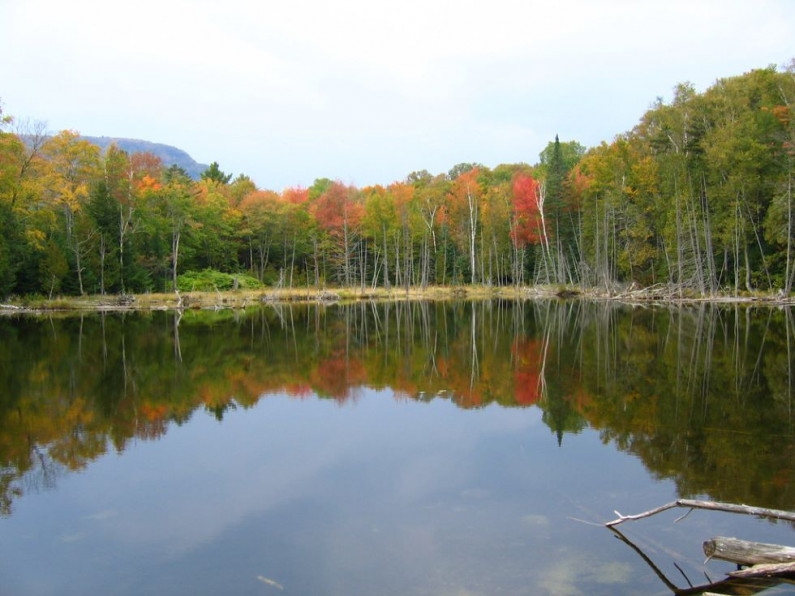High Meadows Fund Awards Grants to Improve Forest Ecosystem Health and Integrity

In collaboration with the Vermont Community Foundation, the High Meadows Fund is putting $218,000 into action over the next two years to launch a new initiative supporting statewide and local efforts to improve forest health and integrity in Vermont.
In this first year, High Meadows is awarding grants to nine projects around the state that foster collaborative approaches to creating resilient, adaptable forests. Healthy forests protect wildlife and contribute to the quality of life of all Vermonters, including those who depend on the forests for their livelihoods.
Some projects are grounded in specific regions of Vermont and seek to strengthen the connectivity between forest parcels, landowners, and other community stakeholders tied to a region’s forested landscape. Others take a statewide approach, focusing on specific opportunities, like bird-friendly maple production, or targeted audiences, like women landowners.
Many of these projects are collaborations between new or unusual partners, often including conservation groups, private landowners, state or municipal government, and stakeholders in the forest industry. “This kind of collaboration holds the greatest potential in advancing both forest health and the forest economy to make our forested landscape more adaptive to today’s environmental challenges,” says Forest, Parks and Recreation Commissioner Mike Snyder. “These projects recognize the vast importance and value of forests in Vermont and far beyond.”
For High Meadows, the long-term success of this nascent initiative includes greater understanding, action, and public commitment to improving the resilience of the forest landscape in the face of disruptive threats such as climate change, non-native species, pests and diseases, and forest fragmentation. And to help achieve these goals, High Meadows is looking to create opportunities for shared learning between these forest grantees. From past work on watershed resilience, High Meadows has gained perspective on the value of a community of grantees exchanging their ideas, experiences, and tools.
High Meadows Fund Forest Health and Integrity Grants— Spring 2019
The American Forest Foundation was awarded $20,000 to promote forest management across Vermont and New York in the Upper Hudson and Lake Champlain watersheds to increase forest diversity and improve habitat for a number of bird species. The project includes an innovative pilot to connect International Paper’s Ticonderoga Mill with landowners interested in managing for bird and wildlife friendly forest management practices.
The Nature Conservancy, in partnership with the Vermont Land Trust and the Stowe Land Trust, was awarded $42,000 to engage landowners and local community members to protect and promote the Shutesville Hill Wildlife Corridor. The corridor connects the Green Mountains and Worcester Mountains, crossing Vermont’s Route 100 on the Stowe/Waterbury town line, and is a crucial linkage in an international network of connected forest habitats.
The Windham Regional Commission was awarded $35,000 to coordinate the Windham South Eastern Connectivity Collaborative. The Collaborative takes a comprehensive view of conservation planning in southeastern Vermont by operating on both regional and local scales. The Windham Regional Commission will be the central point organization to assist grassroots action, including landowner outreach and a citizen science wildlife tracking initiative within a high-priority habitat linkage.
The Vermont Natural Resources Council was awarded $30,000 to enhance work happening at the local level to advise municipalities and regional planning commissions on best ways to comply with Act 171. This will include facilitating trainings for land use planners, foresters, natural resource professionals and municipal officials and conducting a statewide assessment of all town plans and land use regulations, among other efforts.
Women Owning Woodlands, a collaboration between Vermont Coverts, the Vermont Woodlands Association, the Vermont Land Trust, and UVM Extension, was awarded $19,500 to lay the groundwork for a Vermont program to effectively engage women landowners in forest management planning and to address gender-based differences in forest outreach and education.
Audubon Vermont was awarded $39,176 to expand its Bird Friendly Maple program to recognize and support maple producers who have agreed to manage their sugarbushes with practices that promote bird habitat. To accompany the expansion of the program, Audubon will help design an efficacy study to assess the actual benefits to the targeted bird communities.
The Intervale Center was awarded $20,000 to develop a consensus plan for land tracts in the lower Winooski River Valley with competing interests in farming, riparian restoration, forest for habitat, and recreation. This initiative requires working with three municipalities, four non-profits, farmers, Vermont Fish and Wildlife, and US Fish and Wildlife.
Merck Forest & Farmland Center was awarded $8,000, and NorthWoods Stewardship Center was awarded $5,000, to begin outreach and engagement with landowners in their regions of the state. Merck Forest will connect landowners to secure the ecological integrity of 38,000 acres surrounding the Center in the Northern Taconic Mountains, a critical forest block. NorthWoods Stewardship Center will work with landowners towards the ecological integrity of forested lands in Orleans, Caledonia, and Essex Counties in the Northeast Kingdom plan, an area known for its rural character and active forest economy.
###
The High Meadows Fund at the Vermont Community Foundation invests time and money to promote long-term economic vitality and healthy ecological systems in Vermont. Visit highmeadowsfund.org for more information, and follow us on Twitter @HighMeadowsFund.